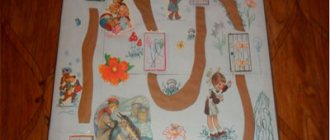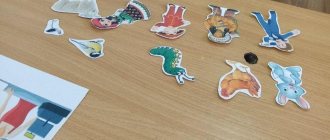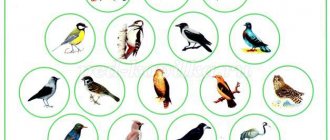Studying music is fun! The best books and manuals for children
Children are very sensitive. They always understand when parents themselves are interested in music and when they are not. Mom often says: “Quickly do the solfeggio assignments.” Do you think a child who also hates this solfeggio will want to study? And if mom says: “What are you studying now? Seventh chords? Did you know that Beethoven uses them so beautifully in the Moonlight Sonata? Don't know "Moonlight Sonata"? So let's listen!"
Of course, you will say that not every parent is a musician and has the time and knowledge. If you studied at a music school (and remember something else), then good. But even if you don’t have the knowledge, it doesn’t matter! We have prepared for you the most interesting books about music, with the help of which it is very easy to interest even the most stubborn!
You might find something from this list useful (almost all books can be downloaded completely free in pdf format):
- “Music Theory for Little Musicians and Their Parents”, author - T.E. Pervozvanskaya
This is both a fairy tale and a textbook that explains musical concepts in a very simple and interesting way.
- “Queen Gamma”, author - E. Poplyanova.
In principle, this author has a lot of good books for beginners that will help a child fall in love with solfeggio.
- “Note ABC”, author N.P. Konchalovskaya
This is a very good book-guide for small and large aspiring musicians
- “The alphabet of music for both preschoolers and primary schoolchildren”, author I.S. Korolkova.
- “Incorrect solfeggio, in which instead of rules there are songs, pictures and different stories!”, author O. Kamozina
A child can read this book on his own, but knowledge of the basics of musical literacy will be required.
- “The ABC of Music in Fairy Tales, Poems and Pictures”, author E. A. Koroleva
This manual is intended for classes with preschoolers (5 and 6 years old), but younger students will also definitely like it. There are a lot of games, poems and stories.
- “Musical education of a child”, authors Lev Madorsky and Anatoly Zak
And this book is needed if you want to understand whether your child should take up music and what needs to be done so that children love and are interested in it.
- “Music from A to Z”, author E. Finkelstein
This is a fairly “old” and well-known book that can still be found in bookstores. Very often, teachers of children's music schools recommend it.
- Manuals by V. Zhilin “How to conduct lessons on playing musical instruments”
His work is based on the K. Orff system, which promotes the formation of creative imagination in a child, instills a love of vocals, music and develops a sense of rhythm. There are very few books by Zhilin on sale.
- “Elementary Theory of Music”, author I. V. Sposobin
And this book is necessary for those who study or want to remember musical literacy.
If you can’t get into the musical theme, but really want to help your child, then give your young musician some time, maybe 2 times a week:
- find out what he is studying
- is he interested
- try playing a music quiz (the questions can be found in the textbooks given above).
To keep interest in music lessons alive, play cartoons with good melodies for your child, for example:
- "Cinderella"
- "Pencil and Eraser"
- "Nutcracker"
- "Ballerina on a Ship"
“Musical and didactic manuals” for preschoolers.
MUSICAL AND DIDACTICAL MANUAL.
Visual material.
During music classes, teachers introduce children to the works of composers. Children are shown portraits of famous Russian and Soviet composers: M. Glinka, P. Tchaikovsky, S. Prokofiev, D. Kabalevsky, D. Shostakovich; modern children's composers: E. Tilicheeva, V. Gerchik, T. Popatenko, M. Kraseva, A. Filippenko and others. The approximate size of the portraits is 30 ´ 50 cm. For ease of use, brief biographical information about each composer is written on the reverse side, available for preschool children. Portraits are placed in the hall and in group rooms (in the music corner in the senior group).
For a more complete artistic and figurative perception by children of the content of the songs they are learning, teachers use pictures1 (the size of the pictures is 30 ´ 50 cm). This helps to clearly explain to children words that are new to them and have unclear meaning.
Pictures are also used while listening to music as an illustration of musical images. For example, before listening to musical excerpts from N. Rimsky-Korsakov’s opera “The Tale of Tsar Saltan,” children look at illustrations of this fairy tale. Many children do not know what a barrel organ is. Therefore, before listening to the play “Hurdy Organ” by D. Shostakovich, it is good to show a picture of it.
Pictures (postcards) depicting various musical instruments
(violin, trumpet, accordion, button accordion, balalaika, etc.) are used to introduce children to these instruments.
The approximate size of the pictures is 25 ´ 30 cm.
Board music and didactic games
2
Musical lotto
– a wooden box with a set of organs (6 pcs.), performing musical sentences from songs familiar to children; wooden plates (lotto cards), divided into squares, in which objects and images of favorite children's songs are depicted (there are also blank ones); chips - small circles of different colors. Musical lotto develops children's perception of musical intonations and melodies, musical memory, and is used for children in senior and preparatory school groups.
"Do, re, mi"
- a game consisting of three large cards with several pictures on each, the plot of which corresponds to the songs the children have learned. Children use chips to cover the pictures depending on the melody they hear. The melodies of the songs are played first by the adult, and then by the child playing the game on any children's musical instrument. Children of the senior and preparatory groups play.
"Recognize the bell"
- a musical and didactic game for children 6–7 years old, consists of 4–5 game cards measuring 15 x 10 cm and colored chips, each of them corresponds to a high, medium or low sound. Cards and chips are placed in a box with two compartments: a large one for cards and a small one for chips, which are made in the form of a colored bell.
To organize the game, use any children's musical instrument or piano. Children practice recognizing a sound (by pitch), look for its place on the game card (where three lines are drawn) and place a chip of the corresponding color on the desired line. The game involves 4-5 children.
"Lay out the melody"
- a musical and didactic game for children 6–7 years old, consists of cards (size 30 ´ 15 cm), a staff, squares for laying out long sounds and rectangles for short sounds. Cards and material for laying out are placed in a box with two compartments - large and small.
To organize the game, a piano or metallophone is used. The game is used to teach children to graphically depict a melody: lay out the rhythmic pattern of the melody on the staff using squares and rectangles, noting long and short sounds in the melody. The game involves 5-6 children.
"Recognize by voice"
– a musical and didactic game for children 2–3 years old. To play, take a small screen and a box with cards depicting various animals, a set of voiced figurative toys (you can offer to find out who is screaming using onomatopoeia from the voice).
The game promotes musical and sensory development. Children develop the ability to distinguish sounds by timbre. Recognizing the voiced figurative toy or the voice of an adult, the child names, showing the corresponding card, and repeats the onomatopoeia (“yap-yap”, “ha-ha-ga”, “yoke-go”, etc.). The game involves from one to 10 children.
"Find Mom"
- a musical and didactic game for children 2–3 years old, consists of cards measuring 15 ´ 10 cm, which are divided into two parts. A picture of mother animals is pasted on one side, and the other is open. In addition to cards, the manual includes pictures measuring 10 ´ 7 cm with images of baby animals. With the help of this game, children are trained in distinguishing sounds by timbre and developing auditory attention.
Children, by the onomatopoeia “quack-quack-quack”, “moo-moo”, “meow”, etc., which is extracted from voiced figurative toys hidden behind a screen (or from the teacher’s voice), recognize who is screaming, and from Several pictures are chosen to cover the empty square on the card with the image of a given animal (“Kitten found its mother”), etc. Each child is given 3–4 cards and the same number of pictures. Any number of children participate in the game.
"Find and show"
– a musical and didactic game for children 2–3 years old. Has 5-6 sets of picture cards (6-8 in each) measuring 10 ´ 7 cm, which depict mother animals or baby animals. Having heard the corresponding onomatopoeia, children pick up a card with a picture of a mother cat or kitten, horse or foal, etc. The display of the picture is accompanied by onomatopoeia in a high or low sound. The game promotes the development of pitch hearing in children. The game involves 5-6 children.
"Find out what instrument sounds"
– lotto, consists of 3–4 cardboard strips measuring 21 ´ 7 cm with images of various musical instruments (three on each strip) and individual cardboard cards, each of which depicts one instrument (12 cards in total): drum , triangle, tambourine, trumpet, piano, violin, button accordion, balalaika, etc.
With the help of games, children are taught to distinguish and name certain musical instruments, and their ear for music and musical memory are exercised. (By analogy, you can organize a game with children's musical instruments.) The game is played with children 6–7 years old.
"Listen carefully!"
The game consists of 6–8 cardboard or wooden cards measuring 10 x 30 cm and 24 multi-colored chips (wooden or plastic circles). Each card has three pictures, conventionally indicating the genre of the musical work. For example: a) a girl rocking a doll (“Lullaby”), b) a boy marching with a drum (“March”), c) a dancing girl in Russian national costume (“Plyasovaya”). Or: a) a dancing girl in a Russian national costume (“Russian Dance”), b) a couple (boy and girl) performing a pair dance (“Polka”), c) a couple (boy and girl) dancing a waltz (“Waltz” ). With the help of the game, educators teach children of senior preschool age to distinguish between genres of musical works. Musical accompaniment for the game is provided in a recording or performed by a piano or children's musical instruments.
"Music Box".
It has a device with a switch, which makes it possible to play 3-4 folk melodies. Children must recognize and name them. The manual has signal buttons that control the quality of tasks: children listen to one of the folk melodies recorded in the box, recognize it and call it, for example: “This is a Russian folk melody!” The teacher presses the button opposite the doll in Russian costume. If the answer is correct, then the doll begins to move.
With the help of this game, the teacher develops in children the ability to distinguish music by character, instills in them a love for the music of the peoples of our country.
The manual is used in working with children of senior preschool age.
Similar problems are solved in another game, “Find out whose music it is” (lotto game). The child, having recognized the melody, uses chips to cover the corresponding pictures on the cards (children in national costumes are depicted). Folk melodies (3–4) are played by the music director or teacher on the piano or one of the children's instruments.
"Spinner"
– a double disk held together by a short rod so that the upper disk (slightly larger than the lower one) can rotate. The lower disk is divided into radii (from 8 to 16); in each sector there is a picture that corresponds to the content of one of the songs familiar to children. The upper disk is bright, colorful, with a window equal to the size of one sector.
The presenter (first an adult, and then a child) moves the upper disk with his hand, in the window of which, when the rotation stops, a picture of the lower disk appears. Children take turns or sing this song together.
With the help of this game, the teacher strengthens the children's ability to sing without musical accompaniment and exercises their musical memory.
"Musical Carousel"
– a movable hexagon (each face measuring 10 ´ 15 cm), made of plywood (can be made of colored plexiglass), attached to a metal rod to a wooden stand (rod height – 20–25 cm). On each side of the hexagon there is a picture (the loop of the picture is placed on a button-nail with a wide plastic head, which is located on each side at its top line).
When playing “Musical Carousel,” children sit in a circle, the teacher or child leader stands in the center of the circle at the table on which the carousel is placed. The presenter spins it, and when it stops, the child looks at the picture that is opposite. Everyone takes turns performing the musical task indicated in the picture: singing, dancing, playing children's musical instruments, etc. (the picture shows a drawing or applique, which, with its content, prompts the children to take the appropriate action).
This game material is used in working with children of senior and preparatory school groups. It helps to strengthen children's singing and motor skills, and their music-playing skills on children's musical instruments; contributes to the acquisition of the ability by children to independently use it in play activities.
"Musical alarm clock"
- a large disk (diameter - 40–50 cm) made of plywood or cardboard, colored plexiglass, in the center of which two arrows are fixed - large and small. The disk is covered with white or colored (light-colored) paper and divided into 8–16 sectors. In the wide part of each sector there is a drawing corresponding in content to any type of children's performing activity: singing, artistic reading, playing children's musical instruments, dance and game task, showing a puppet show, etc. At the bottom of the sector there are pictures-tags. The players agree on which picture-mark will be considered for which child.
The presenter (adult or child) sets the large alarm clock arrow in the picture. A small arrow indicates who will perform this or that task (children will learn about this by the corresponding picture-mark). The presenter announces each child, naming the task he has received. In this way, a concert of children's amateur performances is organized. This game material is used only for preparatory school groups.
"Screen house"
- a small, colorfully decorated house made of plywood, cardboard or wooden construction kit. It has three walls, the fourth is open for various actions of an adult with toys; on the central one there is a window.
To organize games-exercises with a house in younger groups, it is necessary to have small toys (soldiers, nesting dolls, voiced toys, animals). The screen house is used for exercises to develop rhythmic relationships in children, for example: “Who will come to the window in the house: a large or a small nesting doll? Is the soldier walking or running? etc. With the help of this game material, children distinguish sounds by timbre (they recognize birds and animals by their voices), by the pitch of sounds (big - small cockerel, cat - kitten, etc.).
"Paired boxes."
Large wooden box with two compartments. Each contains a figurative toy. The mechanism of the box produces onomatopoeic voices of animals and birds, contrasting in pitch and timbre (cat - kitten, hen - chick, cow - calf, large bird - small, etc.). The game develops children's musical and sensory abilities, strengthens the ability to distinguish sounds by timbre and pitch.
In music classes, teachers use sound and screen (audiovisual) aids to provide various entertainment.





